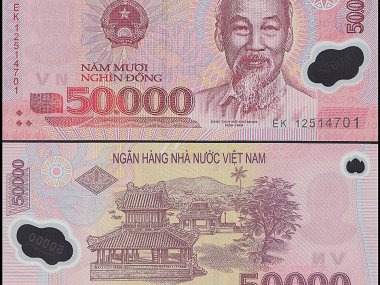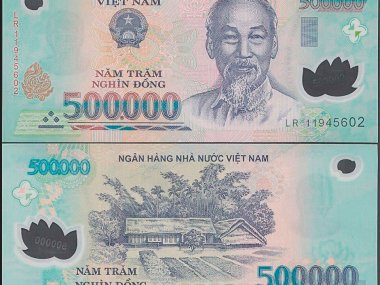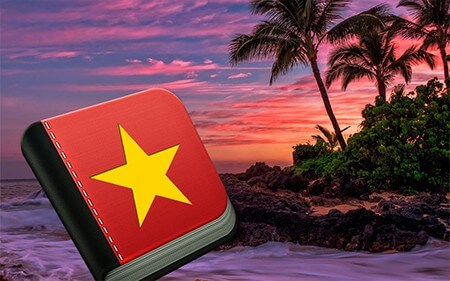Vietnamese currency

Vietnamese currency are bright, colorfully decorated bills with the image of Ho Chi Minh on the front side. The currency of Vietnam is called Vietnamese dongs (VND). All large banknotes, starting with 10 thousand dong, are plastic, and that’s very convenient, because you need not be afraid of making them wet, if you go swimming or wash you money with your cloth. Moreover, Vietnamese currency is considered one of the most protected from counterfeit in the world!
Table of Contents
How does Vietnamese currency look like?
As we’ve said before, on the front of the bills, you can see a portrait of Ho Chi Minh, the beloved leader of the country (he’s now deceased and has a mausoleum in the capital of Vietnam, Hanoi). The images on the back side of the Vietnamese currency vary. The house where Ho Chi Minh was born, and the Hanoi Temple of Literature, and the beautiful Japanese bridge located in the capital of Vietnam can be found here.
In general, there are both paper money and coins in Vietnam, but currently there are practically no coins in use and it is unlikely that you’ll see any. Even two hundred and five hundred paper bills are extremely rare. If you collect metal money from different countries, try to talk to the locals, they probably have some coins for such cases. Some travel agencies sell modern and even antique Vietnamese coins.
At first, it’s difficult for a traveler to deal with Vietnamese money because of the large number of zeros. Very often, when you ask for the prices of the product, you will get an answer without the last 3 zeros, that is, without thousands. For example, if a bottle of water costs 5,000 dongs, when you ask for the price, you usually hear just “5”. After a couple of days, you will be able to easily understand the prices and get an idea about how much different products cost.
Small paper bills
Plastic bills
Here are some examples to help you understand the prices better.
A small bottle of water costs 5000 dong.
A bunch of bananas at the market — about 20000 dong (depending on the season and the harvest, since different fruits and vegetables here are harvested from 2 to 4 times a year).
A portion of the traditional pho soup — from 25000 to 60000 dong.
Lunch at a local tourist oriented restaurant costs about 150000 dong.
For about 500000 dong you can go on an excursion to the nearby attractions.
Caution, fraud!
Keep in mind that not all Vietnamese are honest (although the majority are really very simple-minded and open). While working with tourists, some Vietnamese realized that the people who have just arrived have a poor understanding of prices and are willing to pay the amount they are told, sometimes, tens or even hundreds of times more than the goods cost. There were multiple cases when people bought coconuts on the beach from fruit peddlers for 500 thousand dong. Given that one coconut at the market costs from 5,000 to 10,000 dong (that is, 100 times cheaper). Of course, the cost of coconut in a café or at a peddler is bigger, but you don’t have to pay 100 times more, 25-30 thousand dong is enough. Although sometimes peddlers do not even accept such amounts, spoiled by tourists who pay without thinking.
What is the best currency to bring to Vietnam
It’s better to bring US dollars to Vietnam. You can exchange them literally at every turn. Also you can pay with USD in some venues and receive change, sometimes in dongs, but more often, in the same USDs. There is a good exchange office at the exit of the airport and you can change part of your money here. The exchange rate here is very good, even better than in Mui Ne.
In Vietnam, you can exchange money not also in banks or exchange offices, but in tourist agencies offices, hotels and stores. Be careful when exchanging money on the street. Most of the locals are honest, but someone might try to deceive a newbie who can’t tell the difference between the notes. For example, a 10 000 dong bill visually is very similar to 200 000 bill in color, and 20 000 look like 500 000 and it’s easy to switch them or just confuse by mistake. Keep this in mind when you pay for something.
ATMs in Vietnam
In Vietnam, ATMs are everywhere, so you can bring your credit card. In contrast to neighboring Cambodia, where ATMs give money in US dollars, in Vietnam you can only withdraw dongs. Your national currency will be first converted at the rate of your bank in dollars, and then at the rate of the bank of the ATM in Vietnamese dong. The exchange rate is usually good. But the total commission of your bank and ATM may not be very profitable, especially since you cannot withdraw more than $250 for a single operation at any ATM, and the ATM charges a commission for each operation, as well as your bank (most ATMs even don’t allow you to withdraw $ 250 = 5 million dong, but only allow 100 = 2 million dong or 150 = 3 million dong at a time).




















